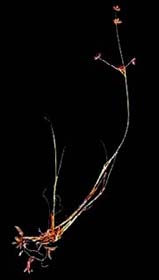
The Xenasmataceae are a family of crust fungi in the order Polyporales. The family was circumscribed in 1966 by German mycologist Franz Oberwinkler with Xenasma as the type genus. As of April 2018, Index Fungorum accepts 28 species in the family. Xenasmataceae fungi grow as saprobes on fallen wood and are known primarily from temperate areas.

The Auriculariales are an order of fungi in the class Agaricomycetes. Species within the order were formerly referred to the "heterobasidiomycetes" or "jelly fungi", since many have gelatinous basidiocarps that produce spores on septate basidia. Around 200 species are known worldwide, placed in six or more families, though the status of these families is currently uncertain. All species in the Auriculariales are believed to be saprotrophic, most growing on dead wood. Fruit bodies of several Auricularia species are cultivated for food on a commercial scale, especially in China.

The Auriculariaceae are a family of fungi in the order Auriculariales. Species within the family were formerly referred to the "heterobasidiomycetes" or "jelly fungi", since many have gelatinous basidiocarps that produce spores on septate basidia. Around 100 species are known worldwide. All are believed to be saprotrophic, most growing on dead wood. Fruit bodies of several Auricularia species are cultivated for food on a commercial scale, especially in China.

The Hyaloriaceae are a family of fungi in the order Auriculariales. Species within the family have gelatinous basidiocarps that produce spores on septate basidia and, as such, were formerly referred to the "heterobasidiomycetes" or "jelly fungi". All appear to be saprotrophic, growing on dead wood or plant remains. Less than 10 species are currently included within the Hyaloriaceae, but the family has not been extensively researched.

Acanthobasidium is a genus of fungi in the Stereaceae family. The genus, which contains three species found in Europe, was circumscribed by mycologist Franz Oberwinkler in 1966.

Entorrhizomycetes is the sole class in the phylum Entorrhizomycota within the Fungi subkingdom Dikarya along with Basidiomycota and Ascomycota. It contains three genera and is are small group of teliosporic root parasites that form galls on plants in the Juncaceae (rush) and Cyperaceae (sedge) families. Prior to 2015 this phylum was placed under the subdivision Ustilaginomycotina. A 2015 study did a "comprehensive five-gene analyses" of Entorrhiza and concluded that the former class Entorrhizomycetes is possibly either a close sister group to the rest of Dikarya or Basidiomycota.

The Mixiomycetes are class of fungi in the Pucciniomycotina subdivision of the Basidiomycota. The class contains a single order, the Mixiales, which in turn contains a single family, the Mixiaceae that circumscribes the monotypic genus Mixia. Only one species has been described to date, Mixia osmundae; this species was originally named Taphrina osmundae by Japanese mycologist Toji Nishida in 1911. It is characterized by having multinucleate hyphae, and by producing multiple spores on sporogenous cells.
Dichopleuropus is a fungal genus in the family Lachnocladiaceae. A monotypic genus, it contains the single species Dichopleuropus spathulatus, found in Malaysia. Dichopleuropus was circumscribed by English mycologist Derek Reid in 1965.
Tubulicium is a genus of fungi in the family Hydnodontaceae. The genus has a widespread distribution, and contains seven species.
Sphaerobasidium is a genus of corticioid fungi in the family Hydnodontaceae. The widely distributed genus contains four species.

The Ceratobasidiaceae are a family of fungi in the order Cantharellales. All species within the family have basidiocarps that are thin and effused. They have sometimes been included within the corticioid fungi or alternatively within the "heterobasidiomycetes". Species are saprotrophic, but some are also facultative plant pathogens or are associated with orchid mycorrhiza. Genera of economic importance include Ceratobasidium and Thanatephorus, both of which contain plant pathogenic species causing diseases of commercial crops and turf grass.

The Tulasnellaceae are a family of fungi in the order Cantharellales. The family comprises mainly effused (patch-forming) fungi formerly referred to the "jelly fungi" or heterobasidiomycetes. Species are wood- or litter-rotting saprotrophs, but many are also endomycorrhizal associates of orchids and some have also been thought to form ectomycorrhizal associations with trees and other plants.

Xenasmatella is a genus of corticioid fungi in the order Polyporales. Circumscribed by German mycologist Franz Oberwinkler in 1966, the widespread genus contains 14 species.
Xenosperma is a genus of corticioid fungi in the order Polyporales. Circumscribed by German mycologist Franz Oberwinkler in 1966, the widespread genus contains four species.
The Agaricostilbales are an order of fungi in the class Agaricostilbomycetes of the division Basidiomycota. They are further classified in the subclass phragmobasidiomycetidae, which contains fungi with basidia that are divided by septa. The order consists of 3 families, 9 genera, and 43 species. The genus Mycogloea is assigned to the Agaricostilbales, although it is of uncertain placement with respect to its family.
The Agaricostilbaceae are a family of fungi in the order Agaricostilbales, part of the Basidiomycota. It was initially circumscribed in 1989 by mycologists Franz Oberwinkler and Robert Bauer. It contains three genera.
The Chionosphaeraceae are a family of fungi in the order Agaricostilbales, part of the Basidiomycota. It was initially circumscribed in 1982 by mycologists F. Oberwinkler and R.J. Bandoni. It contains 3 genera.
Kondoaceae is a family of fungi in the order Agaricostilbales, part of the Basidiomycota. It was initially circumscribed by mycologists R. Bauer, Begerow, J.P. Samp., M. Weiss & Oberw. in 2006. It contains the sole genus Kondoa.
Robert Bauer was a German mycologist, specialising in rust (Uredinales) and smut (Ustilaginomycetes) fungi.











